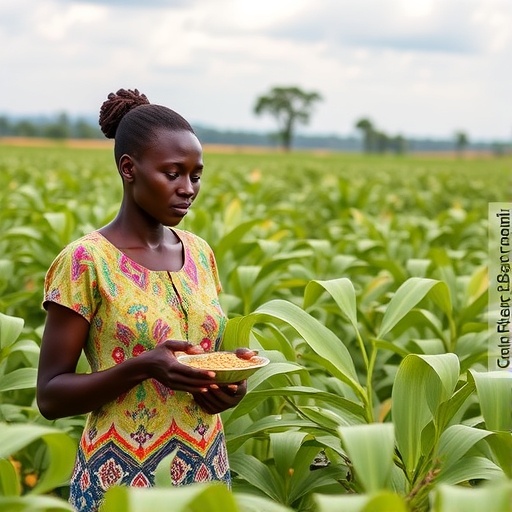The adoption of climate-smart agricultural technologies is increasingly essential as global climate change significantly impacts various agricultural sectors. This necessity becomes particularly pressing in arid and semi-arid regions, where traditional agricultural practices often fall short in sustaining productivity due to climatic stresses. A recent study conducted in Kenya presents a comprehensive analysis of the determinants influencing the adoption of these technologies in groundnut production, focusing particularly on gender dynamics.
Groundnuts, commonly referred to as peanuts in some parts of the world, serve as a vital source of protein and oil and play a crucial role in the livelihoods of many farmers. However, the rising temperatures and unpredictable rainfall patterns associated with climate change threaten the yield and viability of this important crop. As a result, there is an urgent need for farmers to shift towards practices that improve resilience and productivity. The research undertaken by Awoke et al. sheds light on the complexities surrounding the adoption of climate-smart practices, particularly within the context of gender.
The analysis begins by providing an overview of the climatic challenges facing farmers in Kenya’s arid and semi-arid lands. Here, droughts and irregular weather patterns not only reduce crop yields but also destabilize the economic security of farming communities. In such harsh conditions, it becomes imperative for farmers to understand and embrace innovative practices that can help mitigate these effects. This is where climate-smart agriculture steps in, offering strategies that promise not only to bolster groundnut production but also to enhance overall farmer resilience.
The authors of the study emphasize the critical role of gender in the adoption of agricultural technologies. Traditionally, farming practices have been viewed through a male-centric lens, often overlooking the contributions and needs of women. This gender bias can lead to significant discrepancies in technology adoption rates between men and women farmers. In their research, Awoke et al. analyze these discrepancies and explore how empowering women through access to information, resources, and technology can improve adoption rates of climate-smart practices.
One of the key findings of the study is the importance of education and access to information in the adoption process. Farmers who have participated in training programs and workshops are more likely to implement innovative practices in their farming. Education provides farmers not only with the necessary knowledge about climate-smart technologies but also equips them with the skills to effectively utilize these practices in their farming operations. In regions where literacy levels are low, targeted educational initiatives could significantly enhance the understanding and adoption of these vital agricultural practices.
Moreover, the research identifies socio-economic factors as determining elements impacting the adoption of climate-smart technologies. Factors such as land ownership, financial resources, and access to credit often dictate a farmer’s ability to invest in new technologies. Those with secure land tenure and greater financial stability are often in a better position to experiment with and adopt innovative practices. Consequently, the research suggests that creating a supportive economic environment is vital for increasing adoption rates across both male and female farming populations.
Additionally, the role of social networks cannot be overlooked in the discourse of technology adoption. The study reveals that farmers who engage actively in community groups or cooperatives are more likely to adopt climate-smart technologies. Such networks provide platforms for sharing experiences, exchanging knowledge, and accessing resources. These social interactions foster an environment of collective learning and support, which can be instrumental in overcoming the barriers to technology adoption.
Awoke et al. also highlight the significance of government policies and institutional frameworks in enhancing technology adoption. Supportive government policies, such as subsidies for climate-smart inputs and facilitation for access to markets, can create conducive conditions for farmers to embrace innovative practices. Furthermore, strengthening extension services to provide ongoing support and information to farmers is essential in ensuring that they remain informed about new technologies and practices available to them.
It is also critical to consider the environmental and economic impacts of these climate-smart agricultural technologies. The implementation of such practices is not only aimed at improving yield but also at promoting sustainability and reducing the ecological footprint of agricultural practices. For instance, crop rotation, intercropping, and organic farming methods can improve soil health, reduce dependency on chemical inputs, and enhance biodiversity. The research advocates for an integrated approach that balances economic gain with environmental stewardship.
In conclusion, the adoption of climate-smart agricultural technologies is a multifaceted issue influenced by a range of determinants, including gender dynamics, socio-economic status, education, social networks, and policy frameworks. As highlighted in the study by Awoke et al., addressing these factors holistically is essential for fostering an environment conducive to technological innovation in agriculture. The urgent need for adaptive agricultural practices in response to climate change cannot be overstated, and empowering farmers—especially women—is vital for achieving sustainable agricultural development in Kenya’s arid and semi-arid regions.
As we reflect on the findings of this comprehensive study, it becomes evident that the way forward hinges on a collaborative effort among researchers, policymakers, and communities. Ending gender disparities and ensuring equitable access to resources and information will not only enhance the resilience of farming communities but also contribute to broader food security and economic stability in the face of climate change. Moving towards climate-smart agricultural practices is not just about adaptation; it is about transforming the agricultural landscape for future generations.
Subject of Research: Determinants of climate-smart agricultural technology adoption in Kenya
Article Title: Determinants of adoption of climate-smart agricultural technologies and practices in groundnut production: a gender-disaggregated analysis in arid and semi-arid lands of Kenya
Article References:
Awoke, R.W., Kimurto, P. & Okello, D. Determinants of adoption of climate-smart agricultural technologies and practices in groundnut production: a gender-disaggregated analysis in arid and semi-arid lands of Kenya.
Discov Agric 3, 238 (2025). https://doi.org/10.1007/s44279-025-00406-1
Image Credits: AI Generated
DOI: https://doi.org/10.1007/s44279-025-00406-1
Keywords: Climate-smart agriculture, gender dynamics, technology adoption, groundnut production, Kenya, arid lands, semi-arid lands.




